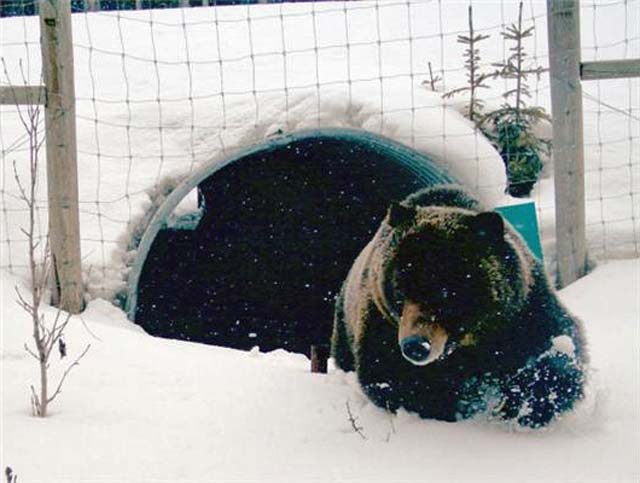
2012
|


A Grizzly bear is captured on a remote camera using a wildlife crossing in Banff National Park - Date unknown
highwaywilding.org.
17 November 2012
Parks Officials to Get Unique Glimpse of Hibernating Bears this Winter
Banff Alberta - As bears start making their way into dens for the winter, officials in Banff National Park are hoping to get a unique
picture of their hibernation routine this year.
Parks Canada staff say an ongoing collaring project could provide some interesting insight on some of the 60 or so Grizzly bears living in the national park as
they head into their dens.
"What it is doing is enabling us a window of observing what they are up to, where they are hibernating, and when they are hibernating, that we wouldn't
normally have by not having the radio collars on them," said Steve Michel, a human-wildlife conflict specialist with Banff National Park.
Eleven Grizzly bears were fitted with GPS collars this spring as part of a five-year research program with Canadian Pacific Railway that aims to prevent deaths
on the tracks. Of those bears, nine still have their collars (one of the batteries died and another had to be removed remotely from a young male Grizzly that
grew too big for its collar this summer).
Michel said the latest GPS data shows the bears spent a lot of time this fall in the Cascade River Valley, which has a rich buffalo berry habitat due to
historic forest fires in the area.
"The bears are looking healthy," he said.
In the past week, the female bears with cubs have made their way to the dens, likely around the time a winter storm tore through much of Alberta.
"Often they den up just as a major storm event is happening," said Michel, noting there are several evolutionary theories as to why that happens.
"One of the theories... is that they like to have their tracks covered. They don't like to have tracks leading into a den location, which makes sense
because you wouldn't want a predator to follow you into a den location when you are vulnerable and you're sleeping."
The young males will follow suit, but Michel warned that large male bears could still be out and about for weeks.
"We expect they will be out, much as they are every year, until Christmas or early January," he said, noting that can present some challenges for
backcountry users. "It's full winter out there on the landscape and you are participating in a winter-oriented activity, but that doesn't mean you aren't
going to bump into a bear or have a bear encounter."
It also means the large male bears can still be found along transportation corridors.
"Unfortunately, these days they will spend a lot of time along the railway tracks because that's when there is increased hauling for grain products,"
said Michel. "There is typically a lot more grain spillage that happens now, so bears do spend time going up and down the tracks.
"That provides an opportunity to continue to nibble away at grain and lentils and peas that are trickling out and occasionally they can find themselves a
carcass as well, a deer or a moose that has been hit along the tracks."
In addition to pitching in on the $1-million research study, CP has spent millions on other measures to keep the tracks clean.
"We're always, always, going to operate our vacuum truck where we can," said CP spokeswoman Breanne Feigel. "We're working closely with Parks
Canada."
"If they see a large spill, for some reason, we will go and actually hand clean it up with our crews."
Feigel said they also report back and forth with parks officials whenever a bear is spotted on or around a particular section of the tracks.
Despite those efforts, two yearling Grizzly bears were killed in early October when they were apparently walking on the tracks near a marshy area in Banff
National Park.
The incident is still being investigated, but officials hope it will provide information that will prevent future deaths.
"We all understood that when we started this five-year action plan, it didn't necessarily mean there wouldn't be any animal fatalities," she said.
"The good piece of it, the silver lining in it, is that now we have the right group of people dedicated to taking these types of tragedies and using it as
part of research to look for the future mitigations."
A total of 13 Grizzly bears have been killed on the tracks since 2000.
Colette Derworiz.

|


|
Vancouver Island
British Columbia
Canada
|
|

